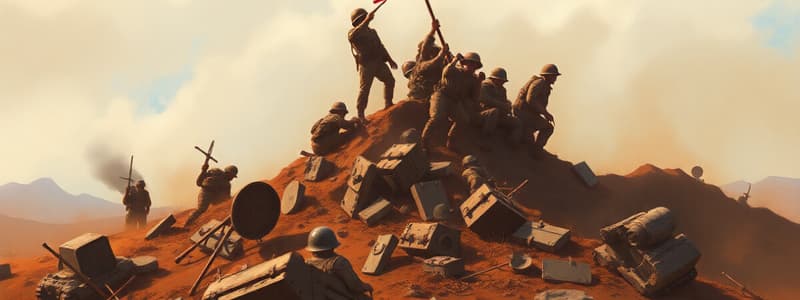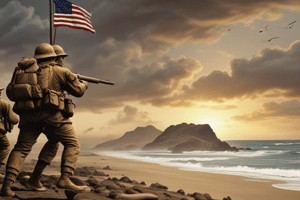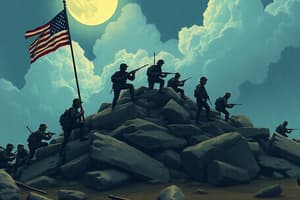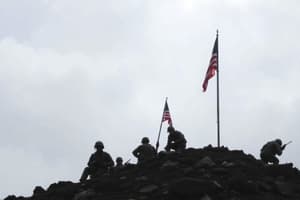Podcast
Questions and Answers
Which of the following was NOT a reason for the U.S. to capture Iwo Jima?
Which of the following was NOT a reason for the U.S. to capture Iwo Jima?
- To establish airfields for fighter aircraft escorting bombing missions
- To secure a strategic location for launching attacks on the Japanese mainland
- To provide emergency landing sites for damaged B-29 bombers
- To prevent the Japanese from using the island as a base for launching attacks on the United States (correct)
What impact did the U.S. air superiority have on Japanese defensive strategies?
What impact did the U.S. air superiority have on Japanese defensive strategies?
- Japanese forces were able to maintain their offensive tactics, despite the lack of air support.
- Japanese forces abandoned their defensive strategies altogether and focused on retreating.
- Japanese forces were forced to adopt more defensive measures, including the construction of fortified strongpoints. (correct)
- Japanese forces relied heavily on air cover to protect their defenses.
What was the primary objective of the Japanese defensive strategy during the Battle of Iwo Jima?
What was the primary objective of the Japanese defensive strategy during the Battle of Iwo Jima?
- To capture the Allied landing beaches and drive them back into the sea.
- To evacuate the island and prepare for a counteroffensive elsewhere.
- To inflict heavy casualties on the Allied forces and delay the advance. (correct)
- To achieve a decisive victory against the Allied forces.
How did the Japanese defensive strategy evolve between the battles of the Central Pacific in 1943 and 1944 and the Battle of Iwo Jima?
How did the Japanese defensive strategy evolve between the battles of the Central Pacific in 1943 and 1944 and the Battle of Iwo Jima?
Which U.S. Marine division was NOT part of the V Amphibious Corps during the Battle of Iwo Jima?
Which U.S. Marine division was NOT part of the V Amphibious Corps during the Battle of Iwo Jima?
What was the approximate number of U.S. service members involved in the assault on Iwo Jima?
What was the approximate number of U.S. service members involved in the assault on Iwo Jima?
Which of the following was the primary force responsible for providing logistical support to the U.S. forces during Operation Detachment?
Which of the following was the primary force responsible for providing logistical support to the U.S. forces during Operation Detachment?
What was the significance of the airfields on Iwo Jima for the U.S. forces?
What was the significance of the airfields on Iwo Jima for the U.S. forces?
What was the primary objective of the Japanese forces on Iwo Jima?
What was the primary objective of the Japanese forces on Iwo Jima?
What tactic did General Kuribayashi discourage his subordinates from using?
What tactic did General Kuribayashi discourage his subordinates from using?
What geographical feature of Iwo Jima aided the Japanese defense?
What geographical feature of Iwo Jima aided the Japanese defense?
What was the primary reason behind the Japanese decision to evacuate all civilians from Iwo Jima?
What was the primary reason behind the Japanese decision to evacuate all civilians from Iwo Jima?
What significant lesson did General Kuribayashi draw from the Battle of Peleliu?
What significant lesson did General Kuribayashi draw from the Battle of Peleliu?
What was the shape of Iwo Jima?
What was the shape of Iwo Jima?
Which of the following beaches were used by the Americans in the assault on Iwo Jima?
Which of the following beaches were used by the Americans in the assault on Iwo Jima?
What is the name of the dormant volcano on Iwo Jima?
What is the name of the dormant volcano on Iwo Jima?
What was the primary objective of Operation Detachment?
What was the primary objective of Operation Detachment?
What was the main reason for targeting Iwo Jima in the Pacific theater strategy?
What was the main reason for targeting Iwo Jima in the Pacific theater strategy?
What was the target date for the Luzon operation?
What was the target date for the Luzon operation?
Which of the following was NOT a key location targeted in the Pacific campaign following the Luzon operation?
Which of the following was NOT a key location targeted in the Pacific campaign following the Luzon operation?
What strategic advantage did the Bonins-Volcano group offer to the Allies?
What strategic advantage did the Bonins-Volcano group offer to the Allies?
What role did the U.S. Army Air Forces play in the decision to target Iwo Jima?
What role did the U.S. Army Air Forces play in the decision to target Iwo Jima?
What was the significance of the Bonins and Ryukus island chains in the context of the Pacific campaign?
What was the significance of the Bonins and Ryukus island chains in the context of the Pacific campaign?
What impact did the Japanese radar site on Iwo Jima have on B-29 bombing missions?
What impact did the Japanese radar site on Iwo Jima have on B-29 bombing missions?
What was the primary purpose of the Navy underwater demolition teams on Iwo Jima?
What was the primary purpose of the Navy underwater demolition teams on Iwo Jima?
What was the result of the air raids on Japanese fortifications prior to the Iwo Jima invasion?
What was the result of the air raids on Japanese fortifications prior to the Iwo Jima invasion?
How long did Task Force 52 manage to provide effective shore bombardment during the Iwo Jima operation?
How long did Task Force 52 manage to provide effective shore bombardment during the Iwo Jima operation?
What were the Marines' feelings towards the decision made by Spruance to detach Task Force 58?
What were the Marines' feelings towards the decision made by Spruance to detach Task Force 58?
At what time did the first assault wave land on Iwo Jima?
At what time did the first assault wave land on Iwo Jima?
What issue did Task Force 52 cite for not carrying out a concentrated bombardment as requested?
What issue did Task Force 52 cite for not carrying out a concentrated bombardment as requested?
What effect did the sudden volume and accuracy of the Japanese artillery have during the assault?
What effect did the sudden volume and accuracy of the Japanese artillery have during the assault?
What did the Marines originally hope for prior to the landings on Iwo Jima?
What did the Marines originally hope for prior to the landings on Iwo Jima?
What was the approximate width of the beachhead concentrated by the Marines?
What was the approximate width of the beachhead concentrated by the Marines?
Which Marine division commenced assault on Mount Suribachi?
Which Marine division commenced assault on Mount Suribachi?
What type of support did Navy destroyers provide during the operation?
What type of support did Navy destroyers provide during the operation?
What was the estimated percentage of pre-assault strength lost by many Marine rifle companies by the end of D+1?
What was the estimated percentage of pre-assault strength lost by many Marine rifle companies by the end of D+1?
What was the main armament used by small teams of Marines to destroy Japanese strongpoints?
What was the main armament used by small teams of Marines to destroy Japanese strongpoints?
During which dates did U.S. forces begin making significant advances against Japanese forces?
During which dates did U.S. forces begin making significant advances against Japanese forces?
What is described as the only kamikaze attack during the operation?
What is described as the only kamikaze attack during the operation?
What did the amphibious landing area consist of in terms of its general shape?
What did the amphibious landing area consist of in terms of its general shape?
What was the fate of General Kuribayashi on March 23, 1945?
What was the fate of General Kuribayashi on March 23, 1945?
What limitation did the Japanese radar station have during the battle?
What limitation did the Japanese radar station have during the battle?
How challenging was it for U.S. escort fighters to operate from Iwo Jima?
How challenging was it for U.S. escort fighters to operate from Iwo Jima?
What was the total number of U.S. casualties during Operation Detachment?
What was the total number of U.S. casualties during Operation Detachment?
How many Medals of Honor were awarded to Marines and Sailors for their actions at Iwo Jima?
How many Medals of Honor were awarded to Marines and Sailors for their actions at Iwo Jima?
What was Admiral Chester W. Nimitz's observation regarding the valor displayed in the battle?
What was Admiral Chester W. Nimitz's observation regarding the valor displayed in the battle?
How many downed U.S. aviators were rescued by aircraft from Iwo Jima?
How many downed U.S. aviators were rescued by aircraft from Iwo Jima?
What was the operational effectiveness of the airfield on Iwo Jima as perceived by the Japanese prior to Operation Detachment?
What was the operational effectiveness of the airfield on Iwo Jima as perceived by the Japanese prior to Operation Detachment?
Flashcards
Operation Detachment
Operation Detachment
The amphibious assault on Iwo Jima during WWII.
Mount Suribachi
Mount Suribachi
The strategic mountain on Iwo Jima where the flag was raised.
Luzon Operation Date
Luzon Operation Date
Target date initially set for the Luzon operation in WWII.
Bonins-Volcano group
Bonins-Volcano group
Signup and view all the flashcards
Ryukus
Ryukus
Signup and view all the flashcards
Strategic bombing campaign
Strategic bombing campaign
Signup and view all the flashcards
Japanese radar site
Japanese radar site
Signup and view all the flashcards
B-29 Bombing Missions
B-29 Bombing Missions
Signup and view all the flashcards
Iwo Jima
Iwo Jima
Signup and view all the flashcards
D-Day
D-Day
Signup and view all the flashcards
Japanese defensive doctrine
Japanese defensive doctrine
Signup and view all the flashcards
Ground forces air cover
Ground forces air cover
Signup and view all the flashcards
Attrition warfare
Attrition warfare
Signup and view all the flashcards
U.S. Fifth Fleet
U.S. Fifth Fleet
Signup and view all the flashcards
Strongpoints and tunnels
Strongpoints and tunnels
Signup and view all the flashcards
D+1 Landings
D+1 Landings
Signup and view all the flashcards
Mount Suribachi Assault
Mount Suribachi Assault
Signup and view all the flashcards
Marine Casualties
Marine Casualties
Signup and view all the flashcards
Japanese Strongpoints
Japanese Strongpoints
Signup and view all the flashcards
General Tadamichi Kuribayashi
General Tadamichi Kuribayashi
Signup and view all the flashcards
Direct Gunfire Support
Direct Gunfire Support
Signup and view all the flashcards
Close-Support Missions
Close-Support Missions
Signup and view all the flashcards
Kamikaze Attack
Kamikaze Attack
Signup and view all the flashcards
Banzai charges
Banzai charges
Signup and view all the flashcards
Operational Momentum
Operational Momentum
Signup and view all the flashcards
Defensive preparations
Defensive preparations
Signup and view all the flashcards
Airfields on Iwo Jima
Airfields on Iwo Jima
Signup and view all the flashcards
Fifth Fleet bombardment
Fifth Fleet bombardment
Signup and view all the flashcards
Landing beaches
Landing beaches
Signup and view all the flashcards
Pre-landing Bombing
Pre-landing Bombing
Signup and view all the flashcards
Navy Underwater Demolition Teams
Navy Underwater Demolition Teams
Signup and view all the flashcards
Concentrated Shore Bombardment
Concentrated Shore Bombardment
Signup and view all the flashcards
Adverse Weather Impact
Adverse Weather Impact
Signup and view all the flashcards
Task Force 58
Task Force 58
Signup and view all the flashcards
H-hour
H-hour
Signup and view all the flashcards
Buildup on the Beaches
Buildup on the Beaches
Signup and view all the flashcards
Enemy Resistance
Enemy Resistance
Signup and view all the flashcards
General Kuribayashi's final act
General Kuribayashi's final act
Signup and view all the flashcards
Japanese radar station failure
Japanese radar station failure
Signup and view all the flashcards
Iwo Jima's airfield utility
Iwo Jima's airfield utility
Signup and view all the flashcards
Logistical challenges of Iwo Jima
Logistical challenges of Iwo Jima
Signup and view all the flashcards
Emergency landing operation
Emergency landing operation
Signup and view all the flashcards
Search-and-rescue operations
Search-and-rescue operations
Signup and view all the flashcards
Casualties of Operation Detachment
Casualties of Operation Detachment
Signup and view all the flashcards
Medals of Honor awarded
Medals of Honor awarded
Signup and view all the flashcards
Study Notes
Background
- Operation Detachment, the Iwo Jima assault, originated from a 1944 conference of Pacific commanders and Joint Chiefs of Staff.
- The plan prioritized securing Luzon, then the Bonin Islands (including Iwo Jima) and Ryukus (including Okinawa).
- Iwo Jima was strategically important as Japanese radar and a potential airbase to intercept US bombers.
- The operation was expected to provide early warning to the home islands, and allow landing spots for damaged B-29 bombers returning from missions.
- Approximately 60,000 US service personnel faced 21,000 Japanese troops.
- Japanese strategy shifted to defensive attrition to delay the inevitable Allied victory.
- Japanese fortifications were heavily fortified and interconnected to weather massive US bombardment.
- The Commander of the Japanese forces (Kuribayashi) employed detailed defensive plans, training his troops to maximize the terrain advantages.
Prelude
- The US Fifth Fleet (Admiral Spruance) was responsible for logistical support and amphibious assaults.
- D-Day was set for February 19, 1945, but the bombardment was reduced to ten days.
- US air superiority crippled the Japanese defense.
- The Japanese strategy was to delay the inevitable clash, using well-fortified defenses.
- Kuribayashi's troops were well-prepared, utilizing defensive positions and tunnels.
- The Marines suffered heavy casualties even after the bombing raids and naval bombardment.
The Battle
- Iwo Jima is an 8 square-mile island shaped like a pork chop.
- It has multiple defensive sectors and landing beaches.
- Primarily two main airfields.
- The initial focus for the Marines was Mount Suribachi.
- The bombing raids and naval bombardment began in June 1944.
- The landing beaches were difficult terrain, including volcanic cinder and ash, leading to combat difficulties for the Marines.
- The Japanese defended beaches, positions on Mount Suribachi and airfields fiercely.
- It took nearly a month of combat to secure the island.
- The capture resulted in significant US casualties.
Aftermath
- 216 Japanese soldiers survived the battle, and an estimated 3,000 went into hiding.
- General Kuribayashi committed suicide on March 23, 1945.
- Despite initial strategic expectations, the island did not have a lasting impact or offer substantial strategic advantage to the US.
- Iwo Jima was declared secure on March 26, 1945.
Studying That Suits You
Use AI to generate personalized quizzes and flashcards to suit your learning preferences.




